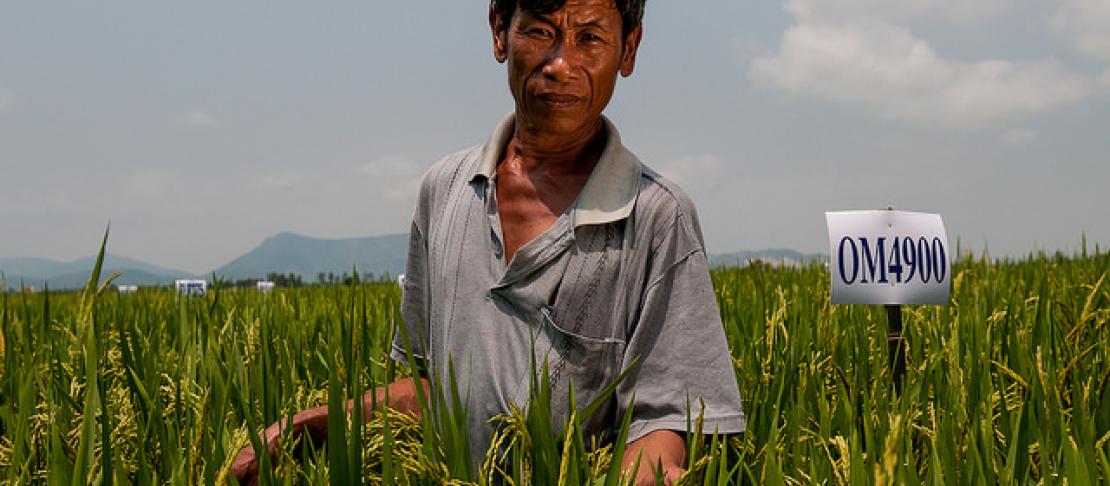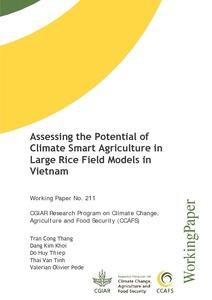Vietnam’s Large Field Models and the potential of climate-smart agriculture

A recent study examines how Large Field Models can help Vietnamese farmers meet the challenges posed by rice production.
Rice is an essential crop in Vietnam. The country is the world’s second largest rice exporter, and the crop is crucial to the food security and livelihoods of millions of Vietnamese, especially farmers living in the Mekong and Red River Delta. Despite the importance of rice, the sector faces serious issues. Not only do current production methods and a reliance on chemical inputs decrease the quality and sustainability of rice crops, but rice production is also seriously threatened by the effects of climate change.
The promotion of Large Field Models (LFMs) throughout the country may help farmers meet the challenges posed by rice production, while facilitating the adoption of climate-smart agriculture (CSA). A recent study, conducted by researchers at the Institute of Policy and Strategy for Agriculture and Rural Development (IPSARD) and the International Rice Research Institute (IRRI), examined Vietnam’s LFMs and the potential of CSA. While the main goal of LFMs is to increase the efficiency of rice production and the quality of rice, they also offer an opportunity to apply CSA principles. LFMs offer reduced production costs, the potential for knowledge sharing, and reduced greenhouse gas (GHG) emissions.
CSA addresses the challenges associated with agriculture, food security and climate change. CSA seeks to sustainably and equitably increase agricultural production, while increasing the resiliency of food systems. In Vietnam, a nationally targeted program on climate change adaptation was approved in 2008. Three years later, in 2011, the National Strategy on Climate Change was established. Combined, these decisions require the agriculture sector to reduce its GHG emissions and poverty by 20 percent while increasing gross outputs by 20 percent.
LFMs are production systems based on the establishment of linkages between farmers and enterprises. They typically gather farmers into large, commonly managed production areas to create favourable conditions for the application of improved technologies and standardized practices for economies of scales, and stabilize output markets for farmers. There are several types of LFMs and their functioning can be characterized by the following: (i) produce annual crops; (ii) use a large production area; (iii) have one or more households involved; (iv) produce crops following Good Agricultural Practices (GAP), and (v) establish linkages between farmers and enterprises with or without contractual arrangements.
Interest in LFM development programs have grown significantly since 2011. As of 2015, 196,000 hectares in the Mekong River Delta were part of an LFM. Major companies and farmers’ cooperatives have also shown interest in advancing LFMs. This interest in LFMs have led to an increase in technical support to farmers and their profits. Research suggests promising results. Studies indicate LFMs are more efficient than individual small farms and that farmers engaged in LFMs have higher levels of productivity and more profits. While researchers were not able to link LFMs to climate change adaptation and resiliency, findings point towards the environmental benefits of LFMs. GHG emissions are reduced through greater efficiencies and changes in farmers’ behaviors. Farmers involved in large-scale rice production were also more concerned about the environmental impact of agro-chemicals.
Despite the benefits, there are several barriers to implementing CSA strategies within LFMs. The small size of farm plots makes it difficult to convince farmers to buy into the program. It is also challenging to determine “benefit sharing methods” for farmers that do agree to contribute their land. Ensuring a fair process between farmers and enterprises is another barrier. Research indicates legal contracts are not always effective due to high costs. Finally, a lack of appropriate infrastructure is a constraint.
While the challenges to LFMs must be taken into consideration, researchers included a number of recommendations for successful adoption of the model. The tailoring of LFMs to specific regions is important, as is encouraging both farmer and enterprise participation. Agriculture insurance markets and infrastructure investments will also be key to both the success of LFMs and CSA strategies. Finally, as previous research indicates, high costs associated with legal contracts, researchers recommend the use of “community value” as a contractual method.
Download the publication: Thang TC, Khoi DK, Thiep DH, Lan VT, Tinh TV, Pede VO. 2017. Assessing the Potential of Climate Smart Agriculture in Large Rice Field Models in Vietnam. CCAFS Working Paper No. 211. Wageningen, the Netherlands: CGIAR Research Program on Climate Change, Agriculture and Food Security (CCAFS).
Kathlee Freeman is a communications consultant with CCAFS and Valerien O. Pede is a Senior Scientist with the International Rice Research Institute.




